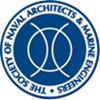Vertical Wedge Drop Experiments as a Model for Slamming
IF 1
4区 工程技术
Q3 ENGINEERING, CIVIL
引用次数: 4
Abstract
A deeper comprehension of hydrodynamic slamming can be achieved by revisiting the wedge water entry problem using flexible structures. In this work, two wedge models that are identical, with the exception of different bottom thicknesses, are vertically dropped into calm water. Pressure, full-field out-of-plane deflection, strain, vertical acceleration, and vertical position are measured. Full-field deflections and strains are measured using stereoscopic-digital image correlation (S-DIC) and strain gauges. A nondimensional number, R, quantifying the relative stiffness of the structure with respect to the fluid load is revisited. An experimental parametric study on the effect of R on the nondimensional hydrodynamic pressure and the maximum strain is presented. It was found there is a sharp change in the trend of pressure and strain when R passes through a critical value. It was also discovered that the structural deformation causes a delay in the peak pressure arrival time and a reduction in the peak pressure magnitude during the wedge water entry. When high-speed planing craft operating in waves becomes airborne and reenters the water surface, a substantial impact or “slam” between the vessel bottom and the water surface will occur (Faltinsen 2005; Lloyd 1989). The bottom slamming events occur frequently and may injure the passengers, compromise the equipment onboard, or even damage the structure. Slamming is a major cause of speed reduction in small craft where slamming loads are important. Current design criteria are primarily based on empirical measurements with little regard for the fluid–structure interaction (FSI) physics of the slamming phenomenon. This study offers a first step toward better understanding of FSI in slamming for optimal structural design in the future. Since the cross sections of most surface effect ships may be approximated by a V-shaped wedge, the slamming characteristics of these sections may be examined by dropping a wedge model into water (Faltinsen 2005; Lloyd 1989). Studying the wedge water entry problem is also helpful in shedding light on the wet deck slamming of catamaran, sloshing under the chamfered roof of a partially filled tank (Faltinsen 2000), seaplane landing (Wagner 1932), water landing of spacecraft and solid rocket boosters, water landing/ditching of aircraft (Abrate 2013), and animal diving behavior (Chang et al. 2016).楔形垂直落锤模型试验研究
通过使用柔性结构重新研究楔形进水问题,可以更深入地理解水动力砰击。在这项工作中,除了底部厚度不同外,两个完全相同的楔形模型被垂直放入平静的水中。测量压力、全场平面外偏转、应变、垂直加速度和垂直位置。使用立体数字图像相关(S-DIC)和应变仪测量全场偏转和应变。对结构相对于流体载荷的相对刚度进行量化的无量纲数R进行了重新计算。对R对无量纲流体动压和最大应变的影响进行了实验参数研究。研究发现,当R通过临界值时,压力和应变的趋势发生了急剧变化。还发现,结构变形导致楔形水进入期间峰值压力到达时间的延迟和峰值压力大小的减小。当在波浪中运行的高速滑行艇在空中飞行并重新进入水面时,船底和水面之间将发生重大碰撞或“撞击”(Faltinsen 2005;Lloyd 1989)。底部撞击事件频繁发生,可能会伤害乘客,危及船上设备,甚至损坏结构。砰击是小型船舶减速的主要原因,其中砰击载荷很重要。目前的设计标准主要基于经验测量,很少考虑砰击现象的流体-结构相互作用(FSI)物理。这项研究为更好地理解砰击中的FSI为未来的结构优化设计提供了第一步。由于大多数表面效应船舶的横截面可以用V形楔来近似,因此可以通过将楔模型放入水中来检查这些截面的砰击特性(Faltinsen 2005;Lloyd 1989)。研究楔形入水问题也有助于揭示双体船的湿甲板撞击、部分装满的水箱斜边屋顶下的晃动(Faltinsen 2000)、水上飞机着陆(Wagner 1932)、航天器和固体火箭助推器的水上着陆、飞机的水上降落/迫降(Abrate 2013)和动物潜水行为(Chang等人,2016)。
本文章由计算机程序翻译,如有差异,请以英文原文为准。
求助全文
约1分钟内获得全文
求助全文
来源期刊

Journal of Ship Research
工程技术-工程:海洋
CiteScore
2.80
自引率
0.00%
发文量
12
审稿时长
6 months
期刊介绍:
Original and Timely technical papers addressing problems of shipyard techniques and production of merchant and naval ships appear in this quarterly publication. Since its inception, the Journal of Ship Production and Design (formerly the Journal of Ship Production) has been a forum for peer-reviewed, professionally edited papers from academic and industry sources. As such, it has influenced the worldwide development of ship production engineering as a fully qualified professional discipline. The expanded scope seeks papers in additional areas, specifically ship design, including design for production, plus other marine technology topics, such as ship operations, shipping economic, and safety. Each issue contains a well-rounded selection of technical papers relevant to marine professionals.
 求助内容:
求助内容: 应助结果提醒方式:
应助结果提醒方式:


